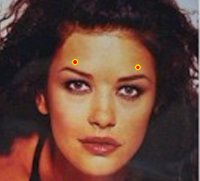Halo Application
Positioning of Patient:
With collar in situ, head just off top of bed (spinal board)
Size the Halo:
Place in approximate position and secure using halo suction cups
Selection of Holes:
2 anterior pin sites:
 |
Centred in groove at upper margin of eyebrows, between
supraciliary ridge and frontal prominences Sagitally, the pins should be placed just superiorly to outer half of eyebrows, to avoid the supraorbital nerve and vessels If Placed too inferiorly, the pins might encroach on the orbit Place as close to midline of eyebrow as possible, as thickest mass of bone is central If placed too medially, the pins might encroach on the frontal sinus Placing pins lateral to the eyebrows under hairline, may case 3 problems: 1. Pins penetrate temporalis muscle, making chewing uncomfortable 2. Temporal bone is thin & penetration or loosening may occur; 3. Lateral position causes posterior pins to be very close to the anterior pins, and multi-plane stability is decreased. |
2 posterior holes:
Placed about 1/4 inch above the ears
This placement of halo ensures that it will be below maximum diameter of skull and the will not migrate superiorly
Pin Insertion:
No need to incise the skin, and not
necessary to shave the patient's hair
have patient close eyes during pin insertion
Each pin should be placed until they just touch the skin, tighten diagonally in
pairs
Consider 6 to 8 in-lbs of tightness (10 in-lbs will begin to pass thru the outer
table)
Avoid unequal tension, halo will migrate
Pin Care:
Tighten carefully once a day for 3
days, and then check for tightness every 3 days 3 more times
Pins should not routinely be tightened more than a full turn at any visit, this
may indicated a loose pin which has migrated into skull's inner table
if such a pin has a torque far less than the optimum, it should be removed and a
new one placed. - in this case, the diagonal opposite must be changed
Traction:
Ten pounds to distract head & five
pounds for each interspace;
Thus C4-C5 fracture dislocation would probably require 30 lbs of traction; -
initially start out with less than this & work upwards after serial radiographs
Complications:
Sixth nerve (abducens) palsy
Loosening: - if pin does not appear to be infected, it can be retightened,
carefully apply a few turns up to the desired 8 in-lbs
Last updated 11/09/2015